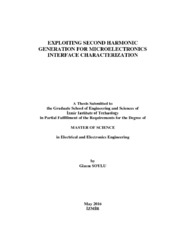Please use this identifier to cite or link to this item:
https://hdl.handle.net/11147/2827| Title: | Exploiting Second Harmonic Generation for Microelectronics Interface Characterization | Other Titles: | İkinci Harmonik Jenerasyon Yöntemi ile Mikroelektronik Arayüzlerin Karakterize Edilmesi | Authors: | Soylu, Gizem | Advisors: | Yüksel Aldoğan, Kıvılcım Dinleyici, Mehmet Salih |
Keywords: | Microelectronic interfaces Second Harmonic Generation Silicon wafers Microelectronic industry Maxwell’s equations |
Publisher: | Izmir Institute of Technology | Source: | Soylu, G. (2016). Exploiting second harmonic generation for microelectronics interface characterization. Unpublished master's thesis, İzmir Institute of Technology, İzmir, Turkey | Abstract: | This thesis aims to develop a technique to characterize microelectronic interfaces based on Second Harmonic Generation (SHG) method. In the experiment part of this study, silicon wafers with thermal and native oxide, silicon-on-insulator (SOI), pure glass and glass with TiO2 thin film samples were used to observe Second Harmonic (SH) signal. The experiments have been performed in IMEP-LAHC laboratory in Grenoble, France. In addition, the measurements were carried out with “Harmonic F1X” which is a femtosecond laser developed by the company FemtoMetrix based in California/USA (FemtoMetrix). Three contributions to SHG were investigated experimentally: the electric dipole approximation due to symmetry breaking at the surface/interface, a dc electric field because of the charge separation at the interface, and lastly bulk contributions. Then, the phenomenological model of surface SHG (Mizrahi & Sipe, 1988) was simulated in MATLAB, and the ratios of the elements of second order nonlinear susceptibility (χzzz/χzii and χizi/χzii) for the silicon wafers were identified with comparing the model with the experimental results. In addition, it was shown that surface and bulk contributions can be separated by using specific polarization states and azimuthal orientations. To show this separation, Fourier coefficients, which describes the crystal facial orientations of the total SHG, were determined for the silicon wafers. Furthermore, it was observed that there are some critical parameters which have an effect to SHG: the polarization states of the incident light and second harmonic light, the angle of incidence of the incoming light and the oxidation types of silicon. Finally, SOI has been used to check whether the effecting factors are same for silicon wafers. The findings demonstrate that SHG is a powerful technique to characterize the surface/interface and the bulk of the sample in microelectronic industry. Bu tez ikinci harmonik jenerasyon (SHG) metodunu temel alarak mikroelektronik arayüzleri karakterize etmek için bir teknik geliştirmeyi amaçlamaktadır. Bu çalışmanın deneysel kısımda, ikinci harmonik (SH) sinyali gözlemlemek için termal ve doğal oksitlenmiş silikon plakalar, yalıtkan üstü silikon (SOI), katıksız cam ve TiO2 ince film kalplı cam kullanıldı. Deneyler Fransa’nın Grenoble şehrinde IMEP-LAHC laboratuarında yapıldı. Bununla beraber, ölçümler Amerika’nın California eyaletinde bulunan FemtoMetrix adlı bir şirket tarafından geliştirilen bir femtosaniye lazer olan ‘Harmonic F1X’ ile gerçekleştirildi (FemtoMetrix). SHG’yi oluşturan üç katkı deneysel olarak incelendi: yüzey/arayüzey simetri kırılmalarından oluşan elektrik dipol yaklaşımı, arayüzeydeki yüklerin birbirlerinden ayrılmasından oluşan dc elektrik alanı ve son olarak yığından gelen katkılar. Yüzey SHG’si için fenomenolojik model (Mizrahi & Sipe, 1988) MATLAB’da simüle edildi, ve doğrusal olmayan ikinci dereceden suseptibilitenin elemanlarının oranları (χzzz/χzii ve χizi/χzii) model ve deneysel sonuçlar karşılaştırılarak silikon plakalar için belirlendi. Ayrıca, yüzey ve yığın katkılarının belli polarizasyon durumları ve azimuthal oryantasyonları kullanılarak ayrılabileceği gösterildi. Bu ayrımı gösterebilmek için, kristalin bütün ikinci harmonik jenerasyonunu oluşturan yüzey oryentasyonlarını tanımlayan Fourier katsayıları, silikon plakalar için bulundu. Bununla beraber, ikinci harmonik jenerasyonu etkileyen bazı kritik parametreler bulundu: gelen ışığın ve ikinci harmonik ışığın polarizasyon durumları, gelen ışığın gelme açısı ve silikonun oksitlenme türleri. Son olarak, silikon plakalara etki eden farktörlerin aynı olup olmadığını karşılaştırmak için SOI kullanıldı. Bulunan sonuçlar gösteriyor ki mikroelektronik endüstrisinde ikinci harmonik jenerasyon malzemenin yüzey/arayüz ve yığınını karakterize etmek için etkili bir teknik olduğunu ortaya koymaktadır. |
Description: | Thesis (Master)--Izmir Institute of Technology, Electronics and Communication Engineering, Izmir, 2016 Includes bibliographical references (leaves: 58-61) Text in English; Abstract: Turkish and English xi, 68 leaves |
URI: | http://hdl.handle.net/11147/2827 |
| Appears in Collections: | Master Degree / Yüksek Lisans Tezleri |
Files in This Item:
| File | Description | Size | Format | |
|---|---|---|---|---|
| T001461.pdf | MasterThesis | 3.12 MB | Adobe PDF |  View/Open |
CORE Recommender
Page view(s)
240
checked on Apr 28, 2025
Download(s)
172
checked on Apr 28, 2025
Google ScholarTM
Check
Items in GCRIS Repository are protected by copyright, with all rights reserved, unless otherwise indicated.